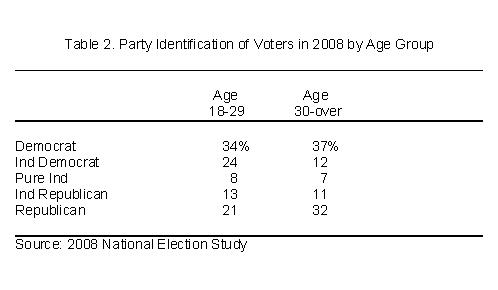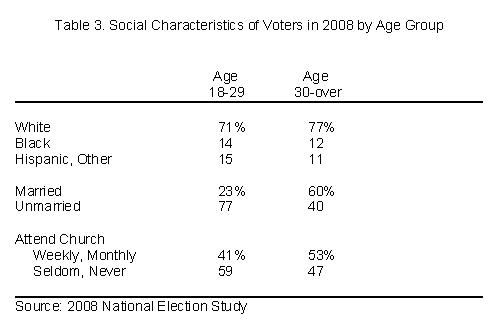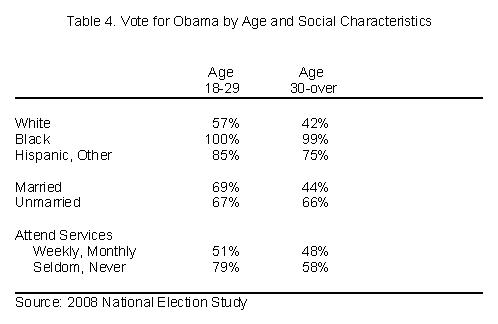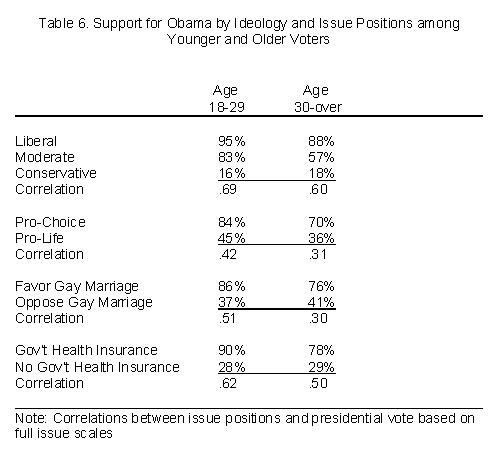The Obama Generation
A Commentary By Alan Abromowitz
Americans under the age of 30 played a major role in the election of Barack Obama as the 44th President of the United States. According to the 2008 national exit poll, 18-29 year-olds made up 18 percent of the electorate and they cast 66 percent of their votes for Obama vs. 32 percent for his Republican rival, John McCain. Based on the exit poll results, we can estimate that of the 132 million Americans who voted in 2008, almost 24 million were under the age of 30 and they provided Barack Obama with a plurality of more than 8 million votes out of his overall plurality of 9.5 million votes. Obama's margin of victory among 18-29 year-old voters was the largest for any presidential candidate since at least 1964. Moreover, the 13 point difference between Obama's 66 percent vote share among 18-29 year-olds and his 53 percent overall vote share was the largest for any presidential candidate since the advent of national exit polls in 1972.
The question raised by these results, of course, is why Barack Obama did so well among young Americans and what his huge margin among this group of voters might mean for the future of American politics. Was this outpouring of support a reflection, as some political commentators have argued, of Mr. Obama's personality, style and celebrity status or did it have deeper roots?
In this article I present evidence from the 2008 American National Election Study that support for Barack Obama by younger Americans was not based primarily on Mr. Obama's personality, style or celebrity status. To a greater extent than among older voters, support for Obama among voters under the age of 30 was based on issues and ideology. The main reason so many young people were attracted to Barack Obama's candidacy was because of his ideas.
The Emergence of a Distinctive Youth Vote
As recently as 2000, there was little evidence of a distinctive youth vote in the United States. The data displayed in Table 1 shows that in that year there was little difference between the candidate choices of younger and older voters. By 2004, however, a significant generation gap had emerged-voters under the age of 30 were seven points more Democratic than older voters in their House vote choices and eight points more Democratic in their presidential vote choices. The gap was about the same in the 2006 midterm elections but by 2008 it had expanded to 12 points in the House elections and 16 points in the presidential election. In eight years, the Democratic share of the presidential vote had increased by 15 points among 18-29 year-old voters but by only one point among older voters while the Democratic share of the House vote had increased by 12 points among 18-29 year-olds but by only two points among older voters. A distinctive youth vote had emerged.
Further evidence that generational differences in 2008 were not limited to presidential candidate preferences can be seen by comparing the party loyalties of younger and older voters. Because party identification is a fairly stable orientation which can influence voting decisions in many elections over an extended period of time, differences between the party loyalties of younger and older voters would provide evidence for the emergence of a durable generational divide in American politics.
At first glance, the evidence from the 2008 National Election Study seems to show that voters under the age of 30 had much weaker attachments to political parties than their elders. Fully 45 percent of 18-29 year-old voters identified themselves as independents compared with only 30 percent of older voters. However, in response to a follow-up question, the large majority of young independents readily acknowledged feeling closer to one of the two major parties. The data displayed in Table 2 show that only 8 percent of voters under the age of 30 were "pure independents" while 24 percent were "independent Democrats" and 13 percent were "independent Republicans." Political scientists have generally found that leaning independents think and act more like partisans than like true independents. In 2008, for example 91 percent of independent Democrats voted for Barack Obama while 82 percent of independent Republicans voted for John McCain.
The evidence in Table 2 shows that after combining leaning independents with partisans, the Democratic Party enjoyed a large advantage over the Republican Party among younger voters in 2008. Fifty-eight percent of voters under the age of 30 identified with or leaned toward the Democratic Party while only 34 percent identified with or leaned toward the Republican Party. Among voters aged 30 and older, the party balance was much closer-49 percent identified with or leaned toward the Democratic Party while 43 percent identified with or leaned toward the Republican Party. The 24 point Democratic advantage in party identification among 18-29 year-old voters was four times the size of the six point Democratic advantage among older voters.
Explaining the Youth Vote: Social Characteristics and Political Attitudes
The emergence of a distinctive youth vote in the United States reflects the fact that younger Americans today have distinctive social characteristics and political attitudes. Evidence from the 2008 National Election Study in Table 3 shows that voters under the age of 30 were less likely to be white, less likely to be married, and less likely to attend religious services regularly than older voters. These differences are politically significant because all of these characteristics are strongly related to party identification and vote choice. Nonwhites, unmarried persons, and those who seldom or never attend religious services are much more likely to identify with the Democratic Party and vote for Democratic candidates than whites, married persons, and those who regularly attend religious services.
Social characteristics alone do not explain the distinctive political behavior of voters under the age of 30, however. The evidence in Table 4 shows that even after controlling for race, marital status, and church attendance, generational differences remained. For example, whites under the age of 30 were much more likely to vote for Barack Obama than whites over the age of 30, married persons under the age of 30 were much more likely to vote for Obama than married persons over the age of 30, and individuals under the age of 30 who seldom or never attended religious services were much more likely to vote for Obama than individuals over the age of 30 who seldom or never attended religious services. Moreover, the existence of differences based on race, marital status, and church attendance begs the question of why these differences exist.
The primary reason for the distinctive political behavior of younger Americans today is that their political attitudes differ significantly from those of their elders. For example, the evidence from the 2008 NES displayed in Table 5 shows that 43 percent of voters under the age of 30 placed themselves on the liberal side of a 7-point ideology scale while only 32 percent placed themselves on the conservative side of the scale. In contrast, only 27 percent of voters over the age of 30 placed themselves on the liberal side of the scale while 46 percent placed themselves on the conservative side.
In addition to this difference in ideological identification, the evidence in Table 5 shows that voters under the age of 30 had different opinions from their elders on several key election issues with the most dramatic difference on the hot-button issue of gay marriage. Fully 62 percent of voters under the age of 30 favored allowing marriage between same sex couples compared with only 32 percent of voters over the age of 30. But gay marriage was far from the only issue on which younger voters differed from older voters. The evidence in Table 5 shows that younger voters were also more liberal than their elders on the issues of abortion and health insurance. The difference on the issue of health insurance was especially striking. While voters over the age of 30 were almost evenly divided on the desirability of a government-sponsored universal health insurance plan, voters under the age of 30 supported such a plan by a better than two-to-one margin. These results indicate that the liberalism of younger Americans today is not confined to cultural issues like gay marriage but extends to more traditional bread-and-butter issues like health care.
Young People as Responsible Citizens
The relatively liberal views of younger Americans go a long way toward explaining the strong support among members of this age group for Barack Obama's candidacy. The evidence in Table 6 shows that it was mainly the liberals among the young who supported Obama. For example, 90 percent of voters under the age of 30 who favored a government-sponsored universal health insurance plan voted for Obama. In contrast, only 28 percent of younger voters who opposed such a plan voted for Obama. Similarly, 95 percent of voters under the age of 30 who placed themselves on the liberal side of the ideology scale voted for Obama while only 16 percent of those who placed themselves on the conservative side of the scale voted for Obama.
Some political commentators have tried to downplay the significance of the youth vote in 2008 by suggesting that young people were attracted to Barack Obama's candidacy primarily because of his personality, style, and celebrity status. Younger voters, in this view, are more likely to be influenced by such frivolous considerations than older and more experienced voters. However, the evidence from the 2008 National Election Study does not support this interpretation. To the contrary, this evidence indicates that the voting decisions of Americans under the age of 30 were actually more strongly related to their ideological and issue positions than the voting decisions of older Americans. For example, the correlation (Pearson's r) between ideological identification and presidential vote was .69 for voters under the age of 30 and .60 for voters over the age of 30. Similarly, the correlation between health insurance position and presidential vote was .62 for voters under the age of 30 and .50 for voters over the age of 30; the correlation between gay marriage position and the vote was .51 for voters under the age of 30 and .30 for voters over the age of 30; and the correlation between abortion position and the vote was .42 for voters under the age of 30 and .31 for voters over the age of 30.
These results indicate that younger Americans were not attracted to Barack Obama's candidacy primarily because of his personality, style, or celebrity-status. Young people reacted to Obama's candidacy primarily based on whether they agreed or disagreed with his political ideology and issue positions. In other words, they acted as responsible citizens.
Dr, Alan Abramowitz is the Alben W. Barkely Professor of Political Science at Emory University, and the author of Voice of the People: Elections and Voting Behavior in the United States
See Other Commentary by Dr. Alan Abramowitz
Rasmussen Reports is a media company specializing in the collection, publication and distribution of public opinion information.
We conduct public opinion polls on a variety of topics to inform our audience on events in the news and other topics of interest. To ensure editorial control and independence, we pay for the polls ourselves and generate revenue through the sale of subscriptions, sponsorships, and advertising. Nightly polling on politics, business and lifestyle topics provides the content to update the Rasmussen Reports web site many times each day. If it's in the news, it's in our polls. Additionally, the data drives a daily update newsletter and various media outlets across the country.
Some information, including the Rasmussen Reports daily Presidential Tracking Poll and commentaries are available for free to the general public. Subscriptions are available for $4.95 a month or 34.95 a year that provide subscribers with exclusive access to more than 20 stories per week on upcoming elections, consumer confidence, and issues that affect us all. For those who are really into the numbers, Platinum Members can review demographic crosstabs and a full history of our data.
To learn more about our methodology, click here.









